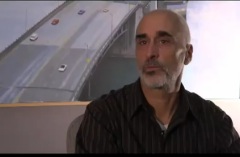
Science Oregon show.
CIty of Portland Bike Coordinator Roger Geller and noted PSU transportation researcher Jennifer Dill star in the latest episode of Green Science Oregon.
The 10-minute segment (watch it below) is a good primer on the current state of Portland’s bike network. It’s also a window into where Portland is heading in the future and how the city plans to reach their goal of 25% bike mode share by 2030.
Here are some quotes from Geller that stood out for me:
Geller says Portland has built, “… probably one of the best bikeway networks in the country for a large city,” but he qualifies it by adding, “If you are a moderately skilled cyclist and you’re somewhat tolerant of automobile traffic, you can easily ride a bike in the city of Portland anywhere you want to go.”
Geller adds that the key right now is creating “higher quality” bikeways with an emphasis on separation.
“The biggest change [in the future] will be what our main streets look like,” says Geller. “The five-foot bike lane is not going to appeal to the masses.”
Jennifer Dill gives a great overview into how research complements the City’s bike planning efforts, sharing insights from her GPS study that tracked the types of bikeways people preferred to ride on. She explains that the majority of people riding now are “young men, perhaps more willing to take risks.” “What type of facility is going to attract different riders? You’ll never get 25% of the people to ride if you’re only getting 18-30 year old men on bikes.”
Watch the video below…


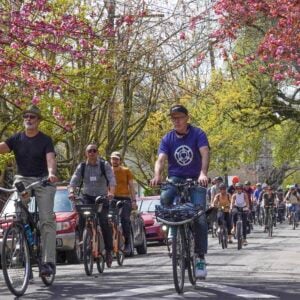
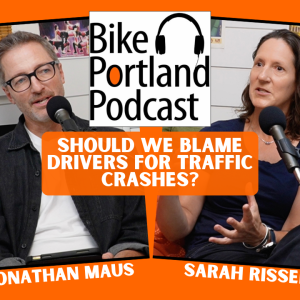
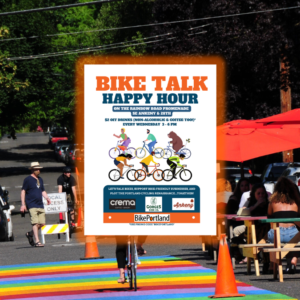
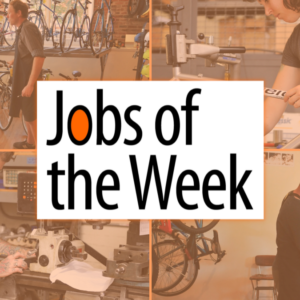
Thanks for reading.
BikePortland has served this community with independent community journalism since 2005. We rely on subscriptions from readers like you to survive. Your financial support is vital in keeping this valuable resource alive and well.
Please subscribe today to strengthen and expand our work.
I call BS on Dill’s demographics, I see plenty of women riding in Portland, and plenty of men over 30. I’d like to see where her data is coming from.
I think the basic assumption that creating facilities which separate cars from bikes on the road in order to increase bike mode split is flawed. Even if we work from the point that Dill and Geller’s research show people feel most uncomfortable around cars on the road, it ignores other factors about the world that greatly effect how and why we can achieve that split. For example, though the BMP has been passed and approved, there is no funding available to actually implement it – making it meaningless. Also, there is a large social stigma against bicycling (yes still, and yes, even here in Portland) which views bikes as toys or maybe for fitness, but not as serious everyday transportation. There are even people who go out of their way to spoon hate and contempt at the cycling community. I didn’t hear Dill or Geller address that issue at all.
Back in the day, when most of us reading were either young or not yet born, a bunch of African Americans got fed up with the state of things which told them they were equal under the law, but were given facilities that were sub-par and they were discriminated against and marginalized. It took a social movement to change some of these things, if only slightly (depending on your interpretation of history), towards real equality. Separate but equal is never either, and it boggles my mind why this community is striving for that.
We will never have the funding, the political power or the social stamina to create a great bike-only network. If we want facilities for the small amount of dollars allotted to be spent, they will have to be on the streets that exist, with cars that still exist. We’ll have to lead by example by following traffic laws, being courteous on the road and keeping our tempers in check. We need to convince other people about the benefits of cycling like saving money, improving fitness, or taking a small step for the environment. This isn’t a process we can engineer our way out of, and by preaching that cycling should be separated from driving only leads more people to believe we shouldn’t be on the roads at all.
It’s great Dill and Geller had this chance to pat themselves on the back and spew a few meaningless numbers and soundbites at us. I’m curious, though, do they ride their bikes to work everyday, or do they just talk to people who do?
BURR #1, where is your “data” coming from?
IMO, they are cherry picking the data to support their agenda, surrounding themselves with people who all agree with them, and ignoring a lot of valid criticism of their plans and designs from large numbers of experienced cyclists.
resopmok,
you have some very important thoughts on this topic… It’s just too bad you had to let yourself slip in that last paragraph to insult Geller and Dill (who both happen to ride bikes everyday.. Geller especially, he’s been riding all over Portland since the early 1990s).
It will be years before we have a network of separated paths and will likely never have a 100% separate bikeway network… in that time, i think you’ll see a lot of that stigma fall away. Already in portland, people expect bike traffic on the roads and that is only increasing.
also, in the coming years it’s likely that more money will be spent on bike projects than in the past.
I think we need a multi-pronged approach. We need a more balanced network (more $$ on bikeways) AND we need a stronger, more vocal community demanding change now and we also need advocates and supporters who wear suits and mix with the bigwigs. throw in some visionary and bold politicians and we could really get somewhere quick.
Elliot, I spend a lot of time on my bike in Portland and walking downtown, I’m speaking from personal experience and observation.
Why is there so much vile, uninformed assumption, and suspicion in these first two comments? It’s like the worst stereotypes of “blogs-as-news-sources” bundled in a nice little package…Happy Halloween!
Burr: Ms. Dill’s demographics are based on robust data from GPS units, supplemented by fairly extensive surveying. They’re also corroborated by years and years of data collection – most longitudinally through the City of Portland’s Annual Bike Counts, and most recently through the National Bike & Pedestrian Data Collection Project – not to mention common sense, and oh yeah, THE CENSUS!
Resopmok: you’re using lots of absolutes. Never say never! Frankly, Ms. Dill and Mr. Geller probably deserve a lot more back-patting than they get. Do you see many other nationally-respected PhDs focusing their research on biking? Drawing national attention – both in the blogosphere and at the political level – to the needs of all people who choose to bike? You can probably count the number of people who fit that bill on one three-fingered hand.
And Mr. Geller’s been riding a bike daily – to work, from work, during work, after work – for many years. He also talks to people who ride bikes, sometimes simultaneously.
interesting you mention the civil rights movement, but then say “we” need to be “courteous,” etc. a lot of what made a black middle class (such as it is) possible in this country was the very real sense, in the sixties, delivered by people who were not too worried about being “courteous,” that the alternative was hell. for every MLK we also need a few Xs.
I’ve been commuting by bike in Portland since 1989. I also have some experience with the Bicycle Advisory Committee and various project-specific PBOT advisory committees and my experience in those areas is that PBOT uses these advisory committees basically to rubber-stamp their plans and agenda, and criticism – even constructive criticism – is not welcomed.
I find the demographic a little questionable myself. Either way, their ideas sound great, but I am always troubled by the desire to improve our ‘exceptional bike network’ when few seem to want to accept that it gets less and less ‘exceptional’ and ‘connected’ the farther one goes into the outer areas of Portland. How about focusing a little on bringing the rest of PDX outside the central area up to the level of the areas that have a good network. It’s also important to remember that Portland isn’t an isolated island. The city should work with its neighbors like Lake Oswego, Tigard, Beavertaon, Gresham, etc. to insure that the networks hook up, because not everyone who lives here has to commute to downtown Portland. Million dollar cycletracks are great, but I can’t help but feel a bit negative towards those things when my commute from the Tigard area to the NE has substandard bike lanes and no safety innovations to speak of prior to getting close to downtown PDX.
BURR #6, that’s pretty much what I assumed. I don’t take issue with your personal observations, but have you considered that maybe the sample of the city you observe regularly isn’t representative of the city as a whole?
You say you see “plenty” of women and men over 30 riding. What do you mean by that? Are you really contesting the counts that only 31% of Portland cyclists are women, like the 2009 PBOT bike counts show? Or are you saying that 31% is already enough?
Jonathan – the ad hom was out of place, agreed, but given the arguments they made in the video, it seemed to me like they weren’t drawing much from personal experience. What I see as a basic lack of respect for cyclists by motorists comes from my day to day interactions with them. It’s my perception that this has worsened over the past few years which to me, means we are losing the “battle for the hearts and minds.” Do people not feel safe on the roads because there are motor vehicles, or are people scared of the manner in which those vehicles are operated? If it is indeed the latter (similar to the argument guns don’t kill people, people kill people), then we should _concentrate_ on changing behavior, not insulating ourselves from it by building separate infrastructure which only serves to deepen the divide.
David: I think one use of the word “never” does not constitute “a lot of absolutes.” Dill and Geller are de facto leaders of a sort, yes, but that doesn’t mean their leadership goes in the right direction. History is rife with bad leaders, should we commend them all for attaining that position?
are: yes I agree that in some cases militancy is needed, but I don’t think we’re there quite yet. If you want to strap a shotgun to your back or keep handlebar mounted holster, all the power to you. Just try to be responsible about it and not PO people for your own kicks.
Compared to almost anyplace else in the US 31% is quite excellent. could it be more? sure.
re #12. In the past few years we have seen plenty of enforcement and engineering, but precious little education.
If people don’t like being around cars so much, why are they driving them so much and dependent on this things they seem to indicate disliking so much? Are we really backed into a corner here? I don’t like the noise pollution of a car, I don’t like the air pollution of a car, I don’t like the stress of owning and driving a car, I don’t like the cost of the car, SO I DON’T OWN OR DRIVE A CAR. How hard is that? Especially in this city.
neat little video but it wasn’t meant for us bike riders… we’ve already heard everything they’re saying…
but if this is getting into the mainstream media that’s great… hopefully it airs on the few channels they list on the website…
Michweek, they’re saying it’s the people on bikes that don’t like the cars around while they bike… the people that own and drive cars; they like the cars and being around the cars just fine…
“…we should _concentrate_ on changing behavior, not insulating ourselves from it by building separate infrastructure which only serves to deepen the divide.” –resopmok
Yes. What happened to kicking the bull out of the china shop (or at least castrating him)? Why are we expending such an effort to hide the china? The assumption is that teaching folks–through proactive education or through enforcing laws–to drive responsibly is a lost cause. “Drivers will be Drivers; not much we can do!” Yes there is: revoke privileges just like my parents did when I acted irresponsibly as a youth.
It’s important for people to realize that behavior/cultural change and building the bike movement are not in the job description of Dill and Geller.
Those things are the job of the community, the advocates, and politicians. If you think not enough is being done on that front, blaming a bureaucrat and a researcher is misguided.
I’m not blaming Dill and Geller for the attitudes of motorists and society. Their research seems concentrated on what might make more people feel comfortable enough to ride more. That is valid research, but unless the measures that need to be taken to make people feel safer are accompanied by measures that increase real safety, we do cyclists a disservice. Furthermore, if the measures that increase cyclist safety are aimed at making life even more inconvenient for cyclists while maintaining or increasing convenience for motorists, we do cyclists another disservice. This latter point does NOT seem to be the desire of Dill and Geller, but if we’re not careful, their conclusions/recommendations could be implemented in a way that forces cyclists (through law or public misconception) onto limited sections of roadway such that travel times are increased and convenience is sacrificed. Making cycling less convenient and more of a novelty will not entice new riders to give up car trips in favor of using the bike.
@ Jonathan #19. I completely disagree. PBOT at one time was professing to follow the ‘four Es’ when it came to bicycling: Education, Engineering, Enforcement and Encouragement.
The education component, and in particular the reeducation of motorists, stands out by its complete absence.
My guess is that this is because the city already has engineers and cops on the payroll, and they need something to do.
On the other hand, mounting an educational campaign typically requires expertise and allocation of funding that is outside of the ‘normal’ city budget and business, i.e. consultants need to be hired, a meaningful message needs to be crafted and agreed upon, and media time and space needs to be purchased.
So the City’s default path of least resistance has been to put all of its eggs in the other three baskets and drop the most important item – education – from its plans.
BURR,
The City runs one of the most comprehensive and large-scale Safe Routes to Schools programs in the country. They teach thousands of kids and introducing bicycling into hundreds of schools each year.
The City also runs the SmartTrips program which helps educate people about the transportation options in their n’hood. that program also holds lots of bike rides and offers bike maps, encouragement, etc…
To say the city has dropped education from its plans is just not true.
That being said, my point is that the City is not the right place where movement-building that will lead to significant cultural change will occur.
Jonathan #22, those are primarily Encouragement programs, and not educational ones.
I’m primarily talking about educating adult cyclists and reeducating adult motorists through PSA campaigns, changes to the driver’s licensing requirements and tests (I know, a state function, not a city one), and so forth.
Motorists by and large don’t have a clue what the state statutes say regarding cycling, as evidenced by all the ‘get on the sidewalk’ type comments almost every cyclist has heard on the street. A lot of novice adult cyclists could also use this information.
This remains a huge and glaring gap in the City’s plans to improve conditions for cyclists.
I also have also been told by a trusted source that the Encouragement folks in Transportation Options rarely interact with the Engineering folks in PBOT that build and design bike infrastructure.
Jonathan (#5) – “in the coming years it’s likely that more money will be spent” – I’m curious why you believe that. I fully expect less money each year, until and unless the current economic and funding situation changes. It’s difficult to justify spending money on separated facilities when there is no funding for police, fire, social services, education, etc. The general public does not understand that some of these funding sources are limited to certain programs.
I believe we need a Plan B – what will we do if funding is cut? What will we do if people argue for less access? What will we do if cycling mode share falls? Despite the best efforts of people like Roger Geller, Jennifer Dill, Linda Ginenthal, April Bertelsen, Steph Routh and Rob Sadowsky, who are all wonderful and hard-working folk; there is a sense of entitlement and accomplishment in Portland, and I fear we’re all too busy patting ourselves on the back to notice there are some real potential pitfalls. I don’t think we should invest a huge amount of resources in contingency planning – the common wisdom is “plan for failure, and you will fail”, and there is some truth to that – but we also shouldn’t be caught completely flat-footed if suddenly the replacement for SAFETEA-LU has no funding for bike/ped projects.
are (#8) – Excellent point. Real change encompasses both those who work within the system and those who want to smash the system. The blessing and the curse of a free society is that no one gets exactly what they want – when any group gets EXACTLY what they want, someone else is suffering.
BURR (#14) – That’s because comparatively, the first two are cheaper. Oddly enough, engineering is frequently the cheapest option from the local perspective, because many of the projects are largely federally-funded.
Education is the most effective, but it will take 20-40 years to see the results, which is why educational solutions are rarely implemented. Studies have shown that the education needs to take place before a person’s attitudes have been “set in stone”, so to speak.
Jonathan (#22) – Last paragraph, I’d argue “occur” should be replaced by “originate”. The city relies on its citizens to originate movement-building, but once the city has a clear mandate from its citizens, it certainly is and has been an active partner. That’s one of the things about Oregon planners like Roger and April, and Milwaukie planners Katie Mangle, Brett Kelver, and Ryan Marquardt that makes those cities such a pleasure to advocate in – they “get it”, and are active participants in producing the change that citizens initiate.
BURR (#23) – How can you say with a straight face that “Safe Routes” isn’t educational?
Educating adults will have lesser returns: once a person develops certain attitudes and opinions, they are much more resistant to change. I’m not saying adult education is useless, but it is less effective and more costly.
The real issue re: education is putting some teeth into the driving test and instituting continuing driver education as a condition of license retention.
Safe routes certainly has an educational component, but it’s still by and large an encouragement program.
It’s as if the city has thrown up its hands and decided it can’t do anything to change motorists’ attitude and behavior, so instead they are going to spend a bunch of money they don’t really have (or will leverage from the feds) in order to build inferior separated facilities that all cyclists will be forced to use. Motorists win again.
🙁
Responding to two points:
I conducted a random phone survey of adults in the Portland region and classified people based upon their current cycling behavior. Males age 18-34 were the most likely to bicyle for transportation at least once a week, year round (23%). Only 7% of women age 18-34 did so and 5% of women age 35-54. I think the City of Portland’s counts confirm that men cycle more than women, though the balance is shifting.
Second, I find it interesting that people would question whether or not I bicycle and judge my research based upon that behavior. If I was studying criminology, as my colleagues two floors above me do, would you judge my research on whether or not I commit crimes? Moreover, there does not appear to be consensus on the topic. On the one hand some people feel that I need to be a regular cyclist to make my work valid, e.g. if I don’t do it, I can’t understand/research it. On the other hand, some people feel that being a cyclist would bias my work, e.g. I have an agenda. My agenda is to do good, solid research that will help practitioners and policy makers make better decisions. As an academic scholar, my work is subjected to blind peer review by other researchers. I conduct my research knowing that it will be subject to such review.
Oh man. I knew I shouldn’t have let my eyes wander past the actual news article. And now I’ve read more than one attempt to connect the civil rights struggle of blacks with transportation planning.
There’s two minutes I won’t be getting back. Sigh.
Ms Dill, is your job research or design? If it is only research, the bias factor we need to worry about is who is paying for the research and what are the answers they are looking for. In this case I have my doubts that politicians want to hear we need to make some social changes if we will ever see a real significant increase in bike usage. Something like the BMP is good for them, because it offers a “solution” without any real commitment or effort on their part. Try telling them that one real big difference between cycling here and in Holland is that in Holland, riding a bike is a perfectly normal, everyday, unstigmatized thing to do. If your job is design, then yes, I expect people to have experience with the purpose of their design output in order to be competent. Would you ask someone without experience in a kitchen to write the menu for your wedding?
My issue with the basic premise of your research and what was stated in the video – that people won’t ride bikes because they worry about the cars in the road and therefore we need separate facilities – is that it doesn’t address the question of _why_. What is it about the cars that makes them feel unsafe? Do they feel just as unsafe around vehicles which are not in operation? Is this fear even founded in reality, or do in fact more people die per vehicle mile traveled on bicycles than in cars? Why must we draw the conclusion that expensive, separate infrastructure for bicycles is necessary when there is plenty of room on existing roads for them now? Why do we spend so much time bending people’s minds to believe that bikes don’t belong on the road, when laws on the books explicitly give cyclists all the same rights (and responsibilities) as the operators of motor vehicles? This is the sort of research I am interested in. Design begins at compromise and ends in failure, at least in my observation of some of the recent “solutions” engineers in this city have come up with recently.
Maybe it’s not the city’s job to change people’s minds about cycling and it’s not really fair to ask that of them. The message I keep getting from the city though, is that it isn’t there to support us in the places where basic laws have already made plenty of usable concrete available. Here’s a simple step toward safety: make a road sign which warns auto drivers in common right hook areas e.g., bike lanes along entrances to strip mall parking lots, right turns at problematic intersections, etc. Then, add this sign to the DMV’s manual and standard roadtest, and maybe even get some cheap advertising with a catchy slogan like “Look before you right hook!” This would probably cost less than $650M, take less than twenty years, and help put a dent in one of the most common causes of accidents between cars and bikes on the road. Might people feel a little more safe on the roads with cars, then?
And John, go build your strawman in the cornfield where the crows can pick at it. My point was to take lessons from the civil rights movement and use them for advancing our own cause, not to compare the way that cyclists are discriminated against in the streets to the way blacks were (and still are) discriminated against. I know learning from history is not something mankind is good at, but I thought, hey let’s give it a shot.
re comment 29, sorry if you can’t see it, but there are in fact issues of social justice in sharing the commons. and actually, some of the same players are involved as in the civil rights struggle which you have somehow encapsulated as having occurred in a fabled past.
re #30 – ‘something that would cost less than $650 million and take less than 20 years’
I’m still waiting for sharrows on a host of inner city arterial streets that are too narrow for bike lanes.
This could be done almost overnight, look how quickly the city installed sharrows on the bike boulevards.
In fact, it could and should have been done ten years ago, what is PBOT waiting for?????
@are Double sigh. I agree that community planning is linked to social justice. That said, for someone to evoke “separate but equal” is just… embarrassing. And it’s not going to win any allies. Minorities of color, sexual orientation, et al are born into stigmas against their very being. To compare it to the mode split we CHOOSE, no matter how good or compelling our choice is, is belittling and co-opting someone else’s struggle.
If some of the same people are involved, fantastic. Obama manages an Afghanistan war and a Dept. of Agriculture. That doesn’t mean the fight against childhood obesity is like the battle against the Taliban.
And, I said four sentences & didn’t mention anything about civil rights being in the “past”. If you’re going to disagree with me, at least read what you’re disagreeing with.
John–
Ok, would it be better to compare transportation policy to Homeland Security policy as it impacts the struggle of Muslims against the prejudice of the Western world? Muslims are subject to higher levels of scrutiny (must be “on their best behavior”) and are also subject to backlash over the siting of worship facilities (you can’t build a mosque there, for crying out loud!) all based on religious beliefs that, no matter how good or compelling, they CHOOSE to hold.
The same principles are at work, regardless of the level of choice the minority in question might have in their minority status (I know–I shouldn’t have used the word minority, because that has racial connotations). As I see it, the discussion of separated bike facilities does evoke “separate but equal” (I think you meant to accuse are of invoking that idea)–not because cyclists are “born that way”, but because the facilities that are usually brought up are separate from the “normal” roadway, and usually far less convenient or safe for cyclists to use, i.e., NOT equal. It is the principle that is a valid comparison, not the identities of the groups involved.
I can compare a hydrogen bomb to the sun because they work in roughly the same way, even though the sun is in no way comparable by size or impact.
i realize it was obscure, but by “some of the same players” i was intending to suggest (for example) that the exploiters who control the resources (money, petroleum, the press) have recruited the working classes (by enslaving them to their automobiles) to run roughshod over the commons with these killing machines. the kind of thing i am talking about when i mention “social justice.” people in cars also being killed, incidentally. but we need to begin to take back the commons. the bicycle is merely one tool. you can describe this as a “choice,” but the alternative is surrender.